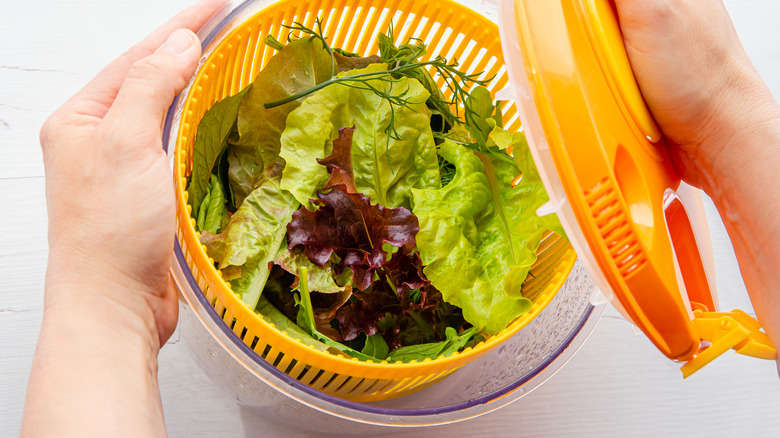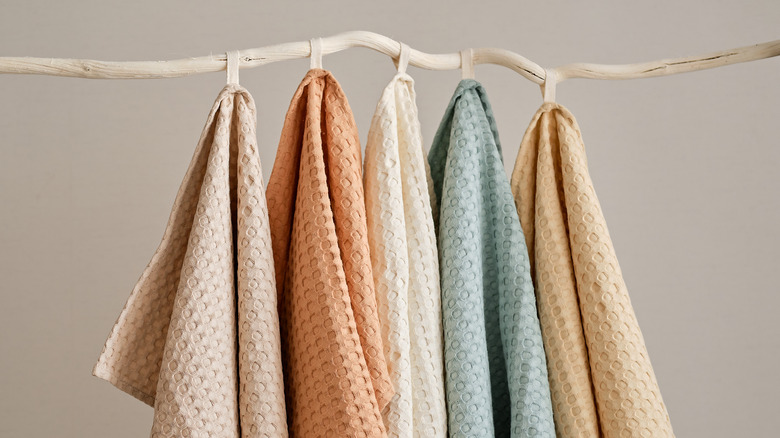You Can Use This Common Household Item If You Don't Own A Salad Spinner
Either way you spin it, a crisp salad is achievable through several techniques. Who says you need a bulky salad spinner to get a thorough cleaning of your lettuce? In fact, if you're only eating salads once in a blue moon, that rambunctious device may collect dust and take up unwanted space.
Patented by Moulinex founder and kitchen gadget connoisseur Jean Mantelet in a time where salad was simply a side dish and not a huge part of the American diet, the device was looked at as another "gourmet gadget" (per Martha Moments) that would be shoved in the pantry with the citrus press and bread machine. Once the '70s hit and healthy eating took on a whole new meaning, people started implementing salads into their meals more and more, states Chris Pearson of PressReader. The salad spinner became a hot item on the market, and sales increased tremendously.
No one wants limp lettuce — in fact, a few spins could take a salad from fine to fantastic when the texture is right. However, some everyday household items may be just as good, saving you time during dish duty with more room in the cupboard.
How do salad spinners work?
Originally created with a crank instead of a push button, the salad spinner uses centrifugal force (similar to clothes dryers, meaning a movement away from a center point) to drain lettuce leaves efficiently in order for salad dressing to stick and not be diluted, per Cook's Illustrated. The gadget we know of today has a removable mesh bowl for easy separating and discarding of that unsightly water – an eye-opener to how dirty that head of romaine from the store could really be.
So when we think of the mechanism behind this invention, the goal is really to just separate lettuce from water. In a spinner, the mesh bowl inside is ridding the lettuce of the water and letting it drain into the larger bowl. Using this same concept, food writer Jill Santopietro (via Chowhound) suggested using a clean cotton pillowcase as a salad spinner substitute if you don't happen to have the kitchen gadget handy.
To do so, rinse lettuce and then place the lettuce inside the pillowcase, cinch it at the top and "spin it around like a centrifuge." Santopietro says you can also apply the same physics using a plastic bag lined with dry paper towels. Simply add the lettuce inside, cinch the plastic bag and spin it like you would with the pillowcase. As with the salad spinner, when we spin lettuce in a pillowcase, we're ridding the water of the lettuce by letting the cotton soak up that liquid, and the same goes for the paper towels in the plastic bag. This helps to clean the lettuce and dry it quicker, too.
Another salad spinner substitute
If you feel like you're not a pro chef without a salad spinner, remember that some of the best cooks in the world use alternatives. Food Network's Ina Garten, the queen of no shortcuts and that "store-bought is fine," uses a secret tool for crisp lettuce that doesn't involve a super spinny bowl: she uses a towel.
Per her appearance on the "Today" show, Garten instructs to place rinsed and drained lettuce leaves onto the center of a clean large towel, fold up the corners to create a bag, and spin it in the air a few times (getting in an arm workout at the same time, too) to allow the towel to fully absorb the liquid and leave you with ready-to-toss leaves. With the help of this makeshift spinner, limp lettuce is a thing of the past and you're on your way to fresher salads with less diluted, more flavorful dressings.
So as you can see, if you don't own a salad spinner, you don't need one to get crisp greens for your salad. The key is understanding how salad spinners work, which then makes creating a salad spinner substitute pretty simple.


